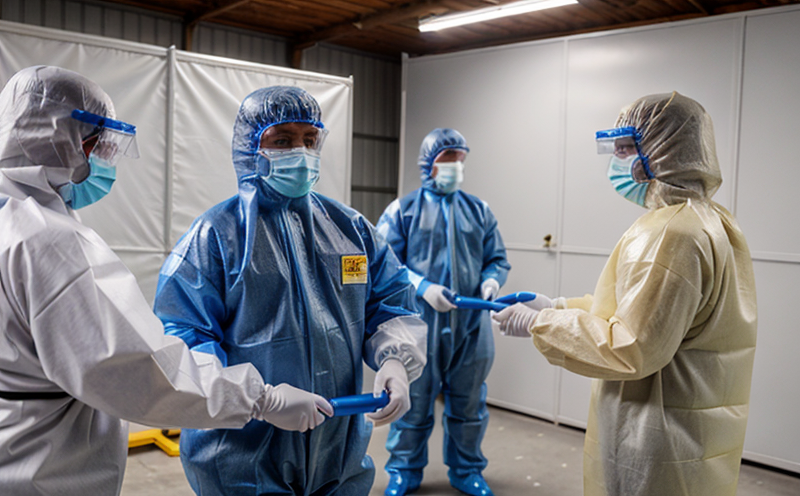DIN EN ISO 11612 Flame resistant safety garments Classification and testing
The DIN EN ISO 11612 standard provides a framework for the classification of flame-resistant protective clothing. This service ensures that textiles meet stringent requirements to protect individuals in hazardous environments, where exposure to heat, flame, or other thermal hazards is likely.
Flame resistance is crucial in industries such as manufacturing, construction, and emergency services, where workers are exposed to fire risks. The standard focuses on the performance of fabrics used in protective clothing under specific conditions that simulate real-world hazards. Compliance with this standard not only ensures worker safety but also provides a competitive edge by demonstrating commitment to safety standards.
The classification system is based on several key parameters including the thermal insulation properties, heat transfer resistance, and heat resistance of the fabric. The tests are conducted in accordance with international standards such as ISO 11612:2019, which specifies the methods for determining whether fabrics can be classified as flame-resistant.
For quality managers and compliance officers, this service is essential to ensure that protective clothing meets or exceeds regulatory requirements. R&D engineers benefit from detailed insights into fabric performance under various thermal stress conditions. Procurement teams gain peace of mind knowing they are selecting products that meet rigorous safety criteria.
The testing process involves several stages:
- Sample preparation: Ensuring the samples are representative and consistent with industrial use.
- Thermal insulation test: Measuring how effectively the fabric resists heat transfer.
- Heat resistance test: Assessing the maximum temperature at which the fabric remains intact.
- Flame propagation test: Evaluating the rate of flame spread across the material.
The results from these tests are used to classify the garments into different categories based on their performance. This classification helps in selecting appropriate protective clothing for specific hazards, ensuring that workers are adequately protected without unnecessary over-protection.
By adhering to DIN EN ISO 11612, organizations can demonstrate a commitment to worker safety and compliance with international standards. This not only enhances reputation but also ensures that products meet the stringent requirements set by regulatory bodies.
Applied Standards
The service is based on DIN EN ISO 11612:2019, which outlines the classification and testing methods for flame-resistant protective clothing. This standard is internationally recognized and provides a comprehensive framework for assessing fabric performance under thermal stress conditions.
The test parameters include:
- Thermal Insulation (TMI): Measures the ability of the fabric to resist heat transfer from one side to another.
- Flame Propagation: Evaluates the rate at which flame spreads across the material surface.
- Heat Resistance: Determines the maximum temperature a fabric can withstand without compromising its integrity.
The standard also specifies the equipment and methods required for conducting these tests, ensuring consistency and reliability in results. Compliance with this standard is crucial for industries where worker safety is paramount, as it provides a benchmark for assessing fabric performance under controlled laboratory conditions that simulate real-world hazards.
Competitive Advantage and Market Impact
Adhering to DIN EN ISO 11612 can provide significant competitive advantages in the market. By offering products that meet or exceed these standards, organizations demonstrate a commitment to worker safety and compliance with international best practices.
From a quality management perspective, this service ensures that all protective clothing is thoroughly tested and classified according to recognized international standards. This not only enhances reputation but also builds trust with clients who value safety above all else.
For R&D engineers, the ability to test fabrics under strict conditions provides valuable insights into material performance and potential improvements. By identifying weaknesses or areas for innovation early in the development process, they can enhance product quality and functionality.
In the procurement phase, selecting products that comply with DIN EN ISO 11612 ensures that organizations are purchasing high-quality protective clothing. This not only reduces the risk of accidents but also minimizes legal liabilities associated with non-compliant products.
The market impact is profound as compliance with this standard can be a differentiator in highly competitive industries where worker safety is a key consideration. It allows companies to offer safer, more reliable products that meet or exceed regulatory requirements, thereby gaining a strategic advantage over competitors who may not adhere to these standards.
Use Cases and Application Examples
- Manufacturing Plants: Workers in areas where sparks or open flames are present can benefit from flame-resistant protective clothing that meets DIN EN ISO 11612 standards.
- Construction Sites: Employees exposed to welding operations or other heat sources require garments that provide thermal protection.
- Firefighting Services: Firefighters need specialized protective clothing that is highly flame-resistant and can withstand extreme temperatures.
- Incident Response Teams: Emergency responders who are involved in hazardous material incidents may use flame-resistant garments to protect themselves from unexpected thermal hazards.
- Energy Sector Workers: Individuals working on offshore oil rigs or nuclear power plants require protective clothing that can withstand high temperatures and potential fires.
In each of these scenarios, the classification and testing process ensures that the protective clothing is suitable for the specific environment and hazards. This not only enhances worker safety but also aligns with regulatory requirements, thereby reducing legal risks for employers.





